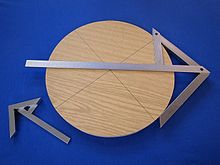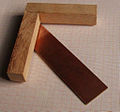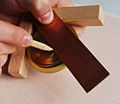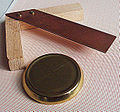Centering angle
A centering square is a scribing tool for determining the center (axis) of shafts or other circular cylindrical workpieces .
A centering bracket has two legs that are arranged at a 90 ° angle. A ruler is attached to the angle, which divides the angle exactly in half.
The circular cylindrical workpiece is placed on the inside of the legs and a marking line is drawn on the ruler with a pen . After rotating the workpiece or the centering bracket (ideally around 90 °), a second marking line is drawn in the same way. The center of the circle and thus the longitudinal axis of the workpiece is located at the point where the two marking lines intersect.
The accuracy can be increased if it is turned twice by 90 ° and two additional lines are marked. If the center of all 4 lines is taken, then the thickness of the pencil lead is also taken into account. In metal processing , the marking of a workpiece is called scribing and is carried out with a scriber.
|
See also: centering , eccentric




